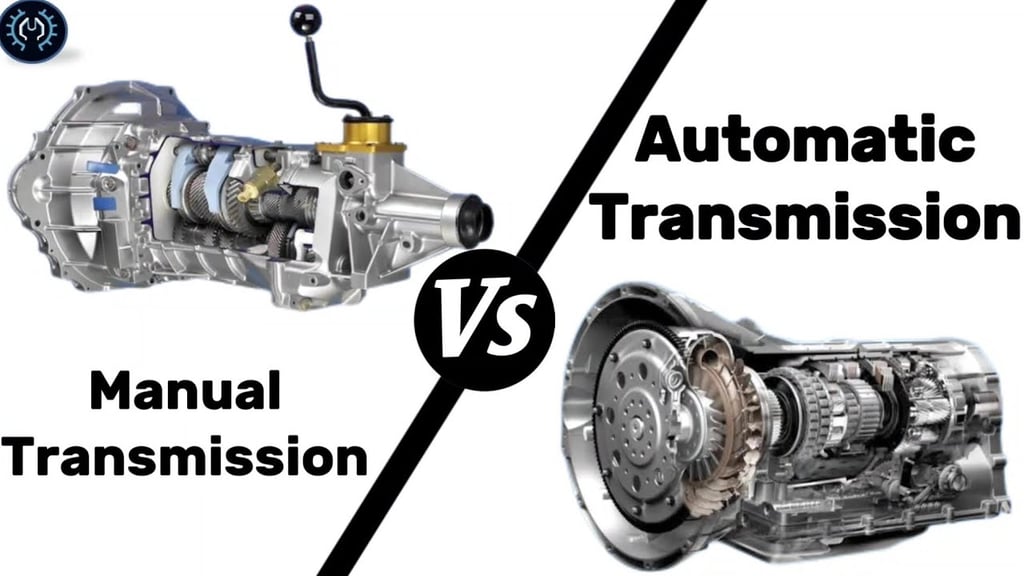Manual vs. Automatic Truck Transmission: Weighing the Pros and Cons
12/19/20244 min read


Understanding Truck Transmissions
Truck transmissions are critical components that facilitate the operation of commercial vehicles by transferring power from the engine to the wheels. The two primary types of truck transmissions are manual and automatic, each offering distinct features and advantages suited to specific trucking needs.
A manual transmission operates through a system of gears controlled by the driver using a clutch pedal and gear stick. This type allows for direct control over gear selection, enabling drivers to adjust their speed and torque precisely according to driving conditions. Manual transmissions are often preferred in situations requiring high levels of control, such as driving in hilly terrains or operating heavy loads.
On the other hand, automatic transmissions utilize a hydraulic system to change gears without driver intervention. This simplifies the driving process, allowing operators to focus more on the road rather than shifting gears. Automatic transmissions have seen a surge in popularity in the trucking industry, largely due to advancements in technology that have improved their efficiency and reliability. They are especially advantageous in urban environments where stop-and-go traffic can be challenging for manual transmission vehicles.
Historically, manual transmissions dominated the market due to their straightforward mechanics and lower production costs. However, with technological advancements and increasing demand for ease of operation, automatic transmissions have become more prevalent. Modern automatic systems, such as those incorporating automated manual transmission (AMT) technology, blend the benefits of both types, offering drivers a compromise between control and convenience.
In summary, both manual and automatic truck transmissions have unique strengths and weaknesses. An operator’s choice will often depend on specific job requirements, preferred driving style, and the operating conditions expected in their line of work.
Pros of Manual Truck Transmission
Manual truck transmissions offer several advantages that can significantly benefit both drivers and fleet operators. One of the most notable advantages is the enhanced control over the vehicle. Driving a truck with a manual transmission allows operators to have a more direct connection with the vehicle, providing better handling and responsiveness, particularly in challenging driving conditions such as steep inclines or rough terrain. The ability to choose gears judiciously enables drivers to optimize power and traction, which can contribute to improved stability and safety while on the road.
Another significant advantage of manual transmissions is their superior fuel efficiency. Manual trucks generally consume less fuel compared to their automatic counterparts, mainly because they allow drivers to shift gears based on real-time driving conditions, enabling optimal engine performance. This is especially beneficial for long-haul operations, where even slight improvements in fuel economy can lead to substantial savings over time. Furthermore, the simplicity of manual transmissions often translates to lower maintenance costs, as they tend to have fewer complex components that may require repair or replacement.
Operating a manual transmission also allows drivers to develop valuable skills and experience. Handling gear shifts requires a level of attentiveness and coordination, fostering a deep understanding of the vehicle's performance characteristics. This knowledge can enhance a driver’s overall driving aptitude and confidence. Moreover, manual transmissions can offer improved vehicle performance in certain situations, such as towing heavy loads or driving in adverse weather conditions, where the ability to control gear selection can capitalize on the vehicle's power band more effectively.
In summary, the advantages of manual truck transmissions encompass enhanced vehicle control, better fuel efficiency, lower maintenance costs, and the skill development opportunities they present for drivers. As such, they continue to be a popular choice among many trucking professionals.
Pros of Automatic Truck Transmission
Automatic truck transmissions have gained popularity in the trucking industry for several reasons, particularly due to their ease of use. Unlike manual transmissions, which require drivers to frequently engage with the clutch and shift gears, automatic transmissions handle these tasks autonomously. This functionality allows drivers to dedicate their attention to the road and other critical aspects of driving, thereby improving overall safety. As a result, operators can concentrate on vehicle positioning and navigation rather than the mechanical intricacies of gear shifting.
Moreover, the reduced driver fatigue associated with automatic transmissions is significant. Truck drivers often spend extended hours on the road, and the continuous need to shift gears in manual trucks can lead to physical discomfort and exhaustion. Automatic transmissions alleviate this strain, allowing for a more comfortable driving experience, which can ultimately contribute to better focus and decision-making during long hauls.
Advancements in automatic transmission technology have further enhanced their appeal. Modern automatic systems are engineered to improve fuel efficiency, competing closely with manual transmissions. With better gear ratio management, they can optimize engine performance, leading to decreased fuel consumption. Additionally, technology such as adaptive transmission systems adjusts to various driving conditions, providing enhanced performance that supports both fuel savings and environmental sustainability.
Automatic trucks also play a vital role in driver training and retention within the industry. With fewer mechanical concerns, training for new drivers can be more streamlined, allowing them to focus on critical driving skills. Furthermore, the ease of learning how to operate an automatic truck can attract a more diverse range of candidates to the profession, ultimately contributing to a healthier workforce in the trucking sector. As these benefits underscore the advantages of automatic transmissions, they position themselves as a compelling choice for modern trucking operations.
Cons of Manual and Automatic Truck Transmissions
Both manual and automatic truck transmissions present distinct drawbacks that can influence a driver's decision regarding their preference for one type over the other. Understanding these limitations is crucial for making an informed choice that suits specific operational needs and driving conditions.
Manual transmissions are often criticized for their steeper learning curve, particularly for novice drivers. New operators may find it challenging to master the coordination of gear shifts and clutch engagement, which increases the likelihood of mismatching engine speed with gear selection. This can lead to premature transmission wear and additional servicing costs. Furthermore, operating a manual requires greater physical effort, as drivers must consistently engage the clutch and change gears, potentially leading to fatigue during long-haul routes.
On the other hand, automatic transmissions, while easier to operate, come with their own set of disadvantages. One significant drawback is the higher maintenance costs associated with these systems. Over time, automatic transmissions may require more frequent and costly repairs due to the complexity of their components, including hydraulic systems and electronic controls. Additionally, automatic transmissions can sometimes be less responsive in specific driving conditions, such as off-road or heavy towing scenarios. This limitation may inhibit optimal performance compared to a manual transmission, which allows for direct driver control over gear selection.
Finally, many drivers report feeling a diminished connection with the vehicle when operating an automatic, as the absence of gear shifting can reduce the engagement and sensory feedback that comes from driving. This disconnection might lead to less attentive driving in challenging conditions. Ultimately, weighing these disadvantages against the advantages of each transmission type will help drivers determine which option is best suited to their unique requirements and driving styles.
Support
Ask questions and share truck repair tips.
Connect
© 2025. All rights reserved.
